

Here is an entertaining giving directions game to play with elementary students. In each team, one player is the 'tank' and the other is the 'driver'. Blindfold the two players who are the tanks and place two soft balls on the floor somewhere in the room. The drivers' task is to guide their tank to a ball by giving directions, e.g. go straight, turn right, etc. When a tank is guided to a ball, the student picks up the ball and has ammunition to fire. Once the tank has the ball, the student takes off their blindfold and fires on the other tank by throwing the ball at them. If the ball hits the tank, the team wins. If the ball misses, the student puts their blindfold back on and the driver guides the tank to the ball again. When a team wins, the game is repeated with the next four students and so on. When everyone has played, the winning teams play against each other to find the ultimate champion.



In this free giving directions speaking activity, students practice giving and following directions to places on a map. In pairs, students take it in turns to ask their partner how they get to the places shown on their worksheet, starting from the pinned location each time, e.g. 'How do I get to the hair salon?' Their partner then gives directions accordingly. When a student has followed the directions, they mark the location on the map. When both students have been given directions to all nine places, they compare their maps to see if they have marked the locations correctly.



In this giving directions worksheet and speaking activity, students learn and practice language used for asking and giving directions. First, students match pictures to directions. Next, students unscramble words to reveal questions that ask for directions. After that, students complete a conversation about asking for and giving directions using the language from the previous exercises. Students then read a dialogue, identify and correct errors with directional language. As a final activity, students create a map of a town by writing in the names of the streets and drawing ten places on the map, e.g. a cinema, restaurant, shopping mall, etc. In pairs, students then take it in turns to ask for and give directions to the places on their map using the directions language on the worksheet.



In this engaging giving directions game, students practice giving and following basic directions. To start, teams decide which side they want to play for, i.e. the Dark Side or Jedi. A player from each team then puts on an appropriate mask or blindfold and is given an inflatable lightsaber or similar object. A member of their team then calls out directions they want their player to move, e.g. go straight, go back, turn left, turn right, etc. When a player is in reach of their opponent, the caller shouts 'hit'. The player then tries to hit their opponent. The first player to do this successfully wins the round and scores a point for their team. Then, a new player from each team puts on a mask and so on. The team with the most points at the end of the game wins.
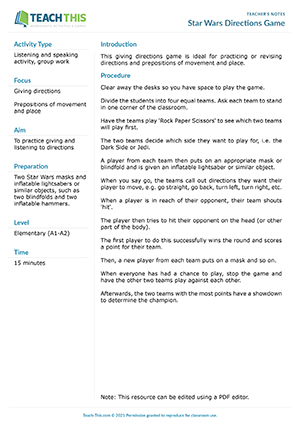


In this communicative giving directions speaking activity, students ask for and give directions to animals and places in a zoo. One student goes first and asks their partner for directions to the animals and places shown on their worksheet. Their partner then gives directions from place to place. When the student has been directed to each place, they mark the location on their map. Their partner then describes what they can see there. The student listens to the description and draws anything they don't have on their map. When the student has been directed to all ten animals and places, the two students swap roles. Afterwards, the two students compare their maps to see if they have marked the locations and drawn the pictures correctly.



In this productive giving directions speaking activity, students practice asking for and giving directions to places on a map. The students' task is to ask their partner for directions to eight places and write the locations on the map. One student goes first and asks their partner for directions to one of the places written on the worksheet. The student listens to their partner's directions and marks the location by writing the name of the place on the map. When the student has found all eight places, students swap roles. Afterwards, students compare their maps and check to see if they have marked the places correctly.



Here is a free giving directions worksheet to help students learn and practice phrases and prepositions related to giving directions. Students start by matching direction phrases to signs. Students then match sentence halves together to make directions that use the phrases. Next, students complete a set of directions using the vocabulary from Exercise A. After that, students complete sentences with prepositions from a box. The sentences explain how each preposition is used. Students then move on to complete directions by choosing the correct prepositions. In the last exercise, students write directions to the nearest hospital and bank using the phrases and prepositions from the worksheet. Afterwards, students read their directions to a partner to see if they are the same or different.
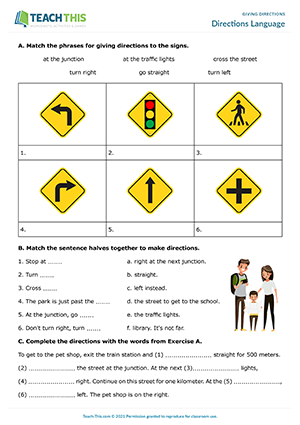


In this creative giving directions activity, students draw pictures that match a set of directions and create directions for a classmate to draw. First, students read directions on the worksheet and draw a picture for each one. Afterwards, students write a new set of directions which they give to another student to draw.
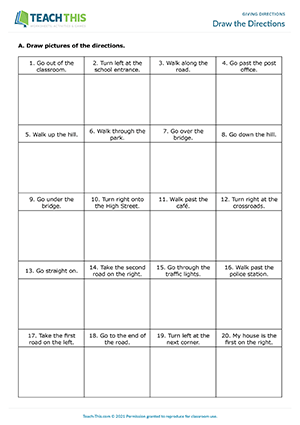


This communicative giving directions speaking activity helps to teach students how to ask for and give directions. Starting from the pinned location, one student asks their partner for directions to the first place on their worksheet. When the student has been directed to each place, they mark the location on their map, and ask for directions to the next place from there. When all ten places have been marked on the map, the two students swap roles. Afterwards, students compare their maps to see if they have marked the locations correctly.
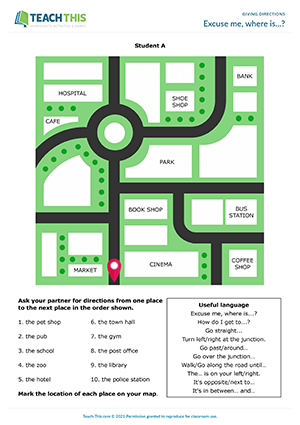


This interesting giving directions game gives students practice at giving and following directions. In the activity, teams play a game where they follow directions to hidden gold stars that have been placed throughout the classroom and building. Students begin by following directions and locating stars hidden inside and outside the classroom. Afterwards, teams hide a gold star somewhere in the building and write directions from the classroom to the location of their star. When the teams come back, they challenge another team to find their gold star by following their directions. The team with the most gold stars at the end of the game wins.



Here is an amusing giving directions game to help students practice giving directions. A player from each team leaves the classroom while a maze is being created. Rearrange the desks to resemble a maze with one entrance and one exit. If a maze of desks isn't possible, create tasks for the players to perform to complete the maze, e.g. sit on a certain chair, open a particular book, touch a specific poster, etc. Once a maze has been created, the game begins with teams taking it in turns to play. The first team puts a blindfold on their player outside of the classroom and then brings them to the entrance of the maze. The aim of the game is for the teams to direct their player through the maze in the shortest possible time. Teams are awarded points according to certain criteria. When all the teams have played, they select new players and students rearrange the desks into a new maze or change the tasks the players have to perform. The team with the lowest score at the end of the game wins.
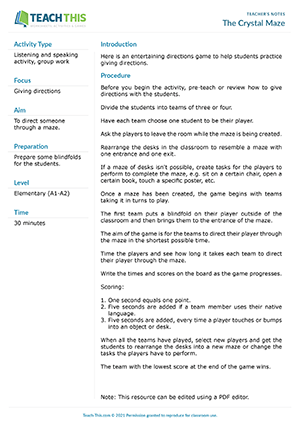


Here is a communicative giving directions speaking activity to help intermediate students review how to give directions. One student begins by giving their partner directions from place to place on their map using the word 'blank' for each destination, e.g. 'To get to 'blank' from Fai's Fashion, go straight on South Street and take the second left, walk along. ' After their partner says the correct destination, the student directs them to the next place, starting from their current location. When their partner has followed directions to all 12 places, students swap roles. The activity continues until both students have been successfully directed to all the destinations.